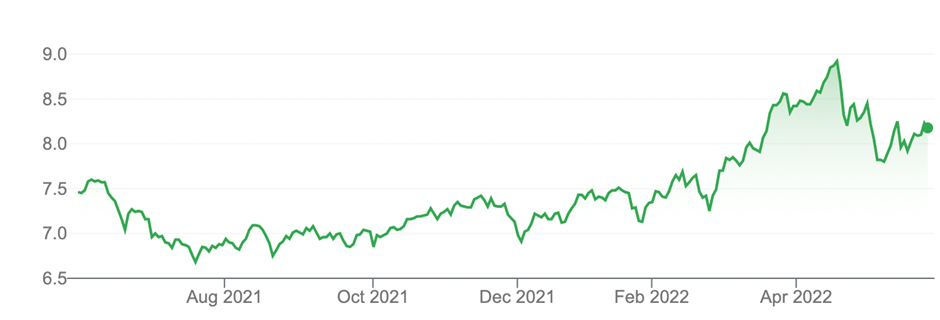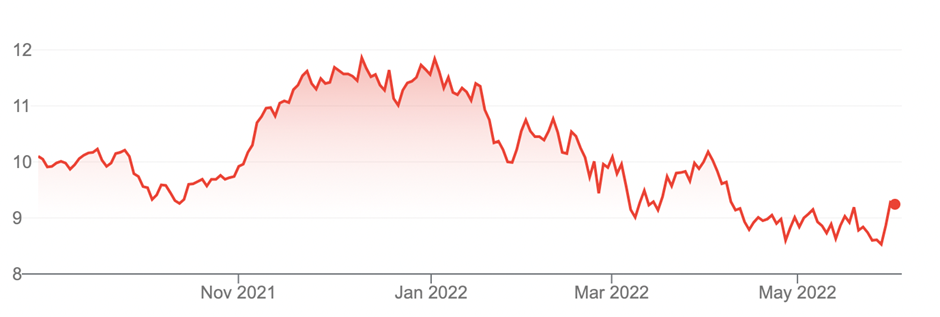Security Alert: Scam Text Messages
We’re aware that some nabtrade clients have received text messages claiming to be from [nabtrade securities], asking them to click a link to remove restrictions on their nabtrade account. Please be aware this is likely a scam. Do not click on any links in these messages. nabtrade will never ask you to click on a link via a text message to verify or unlock your account.
Megatrends investing: five ETFs for the future
Picture this: by 2050, six of the world’s seven largest economies are developing nations: China, India, Indonesia, Brazil, Russia and Mexico. Of developed nations, only the United States (placed third in that list), Germany and the United Kingdom make the top-10 economies by then.
Those forecasts were contained in PwC’s “The World in 2050” report. Much has changed since that report: COVID-19 and Russia’s invasion of Ukraine, for starters. But the broad long-term trends in the report, if not the specific projections, remain intact.
Invariably, the best investment megatrends are the ones staring us in the face. The ones that many investors ignore as they chase the latest thematic Exchange Traded Fund (ETF) to invest in niche technology sectors, after stock valuations peak.
The great investment megatrends last for decades. They include an ageing population, obesity, rising healthcare demand, urbanisation and climate change. The decarbonisation of economies will be the great megatrend of our times.
My point is: long-term investors must ensure their portfolio has sufficient exposure to the most compelling megatrends. By “long-term” investors, I refer to those such as Self-Managed Superannuation (SMSF) trustees and others who have a multi-decade outlook.
Investors often underestimate the power and longevity of true megatrends. Novices latch on to the latest “hot” megatrend, buy at peak valuations when hype abounds, and lose interest in the trend after destroying their capital. That could be the case with some thematic ETFs launched last year at the peak of the tech bull market.
The other enduring feature of megatrend investing is investors not taking advantage of market corrections to add equities exposure at lower prices. By adopting a “set-and-forget” mentality with megatrend investing, they miss opportunities.
My five favourite megatrend-investment ideas are outlined below. I prefer ETFs for megatrend investing, principally because of their simplicity, low cost and ability to pinpoint trends. But don’t discount the value of active managed funds.
I’ve chosen ideas that have reasonable short- and long-term prospects. I don’t believe in identifying long-term opportunities if I think that asset will fall further in the short term. That’s why there are few tech ETFs on this list.
1. India
India’s economy has had many false starts and has struggled to deliver on its promise. For all the hype, Indian equities have performed modestly: the India MSCI Index has an annualised five-year return of about 11% – despite the higher risks.
But as The Economist noted in May, India could benefit from a confluence of trends after the pandemic. India is rolling out a national “tech stack” that is linking its citizens with an electronic identity, tax system and digital bank account. India’s vast, informal, cash-driven economy is being transformed for the 21st century.
Geopolitical developments also favour India. As Western firms increase diversification of their global supply chain (after China did not denounce Russia’s invasion of Ukraine), India looks attractive as a service and possibly manufacturing hub (it can develop cheap energy through solar and, later, hydrogen power).
The ETFS-NAM India NIFTY 50 ETF (ASX: NDIA) is a simple tool for Indian exposure. The Nifty 50 represents about 60% of India’s market value. You won’t get access to emerging, high-growth India companies, but given the risk, I prefer sticking to the largest companies.
Chart 1: ETFS-NAM India NIFTY 50 ETF (NDIA)

Source: ASX
2. Food
I have written positively about the outlook for food demand several times over the last 12 months. Russia’s invasion of Ukraine put a rocket under wheat and other food prices, prompting fears that the world is on the cusp of devastating food shortage.
My focus is long term. The World Bank estimates demand for food will rise by 70% by 2050. To my thinking, food sits at the intersection of powerful megatrends. As the global population expands, more food will be needed. As billions of people from developing nations join the global middle class in the next three decades, diets will change. Higher food demand, particularly for proteins, will follow.
At the same time, the supply of arable land will continue to shrink, placing even greater emphasis on agricultural technology and other productivity gains.
The BetaShares Global Agriculture ETF (ASX: FOOD) is the best way to gain exposure to global agriculture companies via ASX. FOOD invests in 58 of the world’s largest agricultural companies. About a third of the ETF is in fertilisers and ag chemicals.
FOOD has rallied in the past two years. But it’s been a modest medium-term performer over five years: the annualised return is 10.3% to end-April 2022. FOOD could be volatile in the next 12 months but has good long-term prospects.
Chart 2: BetaShares Global Agriculture ETF (FOOD)

Source: ASX
3. Ageing
By 2050, there will be 2 billion people aged over 60, estimates the United Nations. That means one in five people on the planet by then will be 60 or over – in a period of population ageing that is “without parallel in human history”, notes the UN.
It’s incredible to think how ageing will change the world. Developing nations, such as India, with their younger populations, could have a big advantage over developed nations. Japan’s economy continues to struggle with an ageing population, as will China’s.
Healthcare is an obvious winner from an ageing population. So, too, automation and robotics firms that develop technology to help older people. Providers of retirement savings products will also benefit. Because ageing will affect so many industries, investors need to take a broad view with their demographic exposure.
I like the Fidelity Global Demographics Fund for exposure to an ageing global population. Available through an ETF structure on ASX (FDEM), the Fund is actively managed. Its main themes are population growth, ageing and the rise of middle-class consumers.
Chart 3: Fidelity Global Demographics Fund (FDEM)

Source: ASX
4. Semiconductors/cloud computing
It’s hard to separate my two favourite technology megatrends. Semiconductor demand has excellent long-term fundamentals as billions of new devices require chips to connect them to the Internet of Things, for artificial intelligence to analyse.
In April, McKinsey predicted the global semiconductor industry was poised for a decade of growth and would become a “trillion-dollar industry by 2030 (from US$600 billion in 2021).
As computer chips in connected devices capture more information, companies will need more places to store the data. The amount of data being captured, analysed and stored will be mind-boggling. That’s good for leaders in cloud-computing storage.
The ETFS Semiconductor ETF (SEMI) is a useful tool to gain exposure to global semiconductor firms. In cloud computing, I favour the BetaShares Cloud Computing ETF (CLDD).
Both ETFs are well down on a year-to-date basis, in line with broader weakness in global tech shares.
Chart 4: ETFS Semiconductor ETF (SEMI)

Source: ASX
5. Climate change
Led by soaring energy and gas prices, many fossil-fuel stocks have soared this year. At the same time, renewables have been under price pressure.
Investing for climate change is complicated. I see continued strong demand for fossil fuels as large developing nations dominate the global economy by 2050. Sadly, they will need fossil fuels to do so. It’s hard to see the larger emerging markets forgoing cheap energy in the name of the environment.
Emerging markets have watched developed nations benefit from cheap energy for decades. Right or wrong, emerging markets will want the same opportunity. There will be rising demand for fossil fuels in developing markets at a time of constrained global supply due to underinvestment in oil, coal and other fossil-fuel projects.
However, in terms of long-term megatrend investing, I prefer the decarbonising side of the equation. That is, backing long-term winners from climate change and avoiding the losers. I also find it hard to buy energy stocks right now after such a strong rally in the past 18 months. The underperformance of renewables in that period has created a more attractive entry point for long-term investors.
BetaShares’ Climate Change Innovation ETF (ERTH) is a useful index fund for long-term exposure to companies driving climate-change technologies. ERTH tracks up to 100 global companies that earn at least half of their revenue from “green activities”.
ERTH is down 27.8% over six months. Renewable stocks, generally, have underperformed as fossil-fuel shares have soared following Russia’s invasion of Ukraine.
Megatrend investors could take advantage of this price weakness to add climate-change exposure to their portfolio by investing in the world’s best renewable-energy companies.
Chart 5: BetaShares Climate Change Innovation ETF (ERTH)

Source: ASX
Tony Featherstone is a contributor to The Switzer Report. All prices and analysis at 03 June 2022. This information was produced by Switzer Financial Group Pty Ltd (ABN 24 112 294 649), which is an Australian Financial Services Licensee (Licence No. 286 531This material is intended to provide general advice only. It has been prepared without having regard to or taking into account any particular investor’s objectives, financial situation and/or needs. All investors should therefore consider the appropriateness of the advice, in light of their own objectives, financial situation and/or needs, before acting on the advice. This article does not reflect the views of WealthHub Securities Limited.
